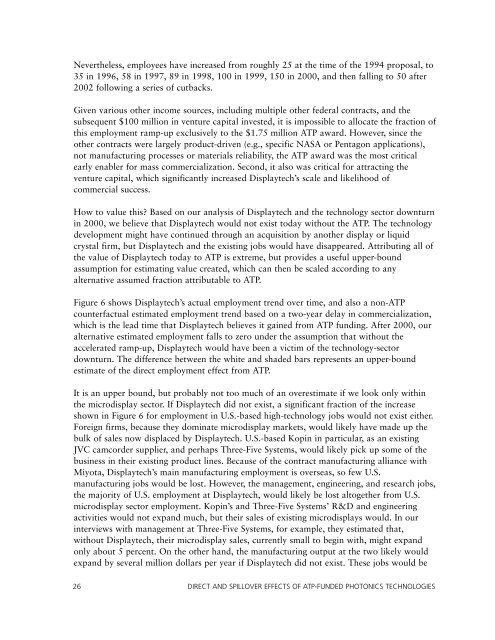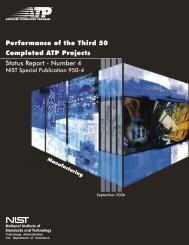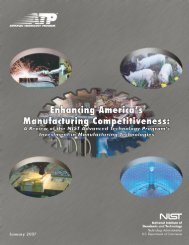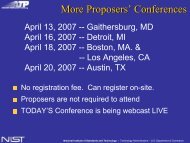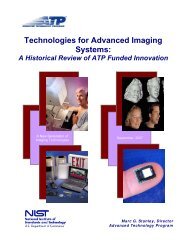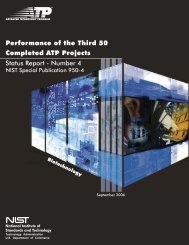Direct and Spillover Effects of ATP-Funded Photonics Technologies
Direct and Spillover Effects of ATP-Funded Photonics Technologies
Direct and Spillover Effects of ATP-Funded Photonics Technologies
- No tags were found...
You also want an ePaper? Increase the reach of your titles
YUMPU automatically turns print PDFs into web optimized ePapers that Google loves.
Nevertheless, employees have increased from roughly 25 at the time <strong>of</strong> the 1994 proposal, to35 in 1996, 58 in 1997, 89 in 1998, 100 in 1999, 150 in 2000, <strong>and</strong> then falling to 50 after2002 following a series <strong>of</strong> cutbacks.Given various other income sources, including multiple other federal contracts, <strong>and</strong> thesubsequent $100 million in venture capital invested, it is impossible to allocate the fraction <strong>of</strong>this employment ramp-up exclusively to the $1.75 million <strong>ATP</strong> award. However, since theother contracts were largely product-driven (e.g., specific NASA or Pentagon applications),not manufacturing processes or materials reliability, the <strong>ATP</strong> award was the most criticalearly enabler for mass commercialization. Second, it also was critical for attracting theventure capital, which significantly increased Displaytech’s scale <strong>and</strong> likelihood <strong>of</strong>commercial success.How to value this? Based on our analysis <strong>of</strong> Displaytech <strong>and</strong> the technology sector downturnin 2000, we believe that Displaytech would not exist today without the <strong>ATP</strong>. The technologydevelopment might have continued through an acquisition by another display or liquidcrystal firm, but Displaytech <strong>and</strong> the existing jobs would have disappeared. Attributing all <strong>of</strong>the value <strong>of</strong> Displaytech today to <strong>ATP</strong> is extreme, but provides a useful upper-boundassumption for estimating value created, which can then be scaled according to anyalternative assumed fraction attributable to <strong>ATP</strong>.Figure 6 shows Displaytech’s actual employment trend over time, <strong>and</strong> also a non-<strong>ATP</strong>counterfactual estimated employment trend based on a two-year delay in commercialization,which is the lead time that Displaytech believes it gained from <strong>ATP</strong> funding. After 2000, ouralternative estimated employment falls to zero under the assumption that without theaccelerated ramp-up, Displaytech would have been a victim <strong>of</strong> the technology-sectordownturn. The difference between the white <strong>and</strong> shaded bars represents an upper-boundestimate <strong>of</strong> the direct employment effect from <strong>ATP</strong>.It is an upper bound, but probably not too much <strong>of</strong> an overestimate if we look only withinthe microdisplay sector. If Displaytech did not exist, a significant fraction <strong>of</strong> the increaseshown in Figure 6 for employment in U.S.-based high-technology jobs would not exist either.Foreign firms, because they dominate microdisplay markets, would likely have made up thebulk <strong>of</strong> sales now displaced by Displaytech. U.S.-based Kopin in particular, as an existingJVC camcorder supplier, <strong>and</strong> perhaps Three-Five Systems, would likely pick up some <strong>of</strong> thebusiness in their existing product lines. Because <strong>of</strong> the contract manufacturing alliance withMiyota, Displaytech’s main manufacturing employment is overseas, so few U.S.manufacturing jobs would be lost. However, the management, engineering, <strong>and</strong> research jobs,the majority <strong>of</strong> U.S. employment at Displaytech, would likely be lost altogether from U.S.microdisplay sector employment. Kopin’s <strong>and</strong> Three-Five Systems’ R&D <strong>and</strong> engineeringactivities would not exp<strong>and</strong> much, but their sales <strong>of</strong> existing microdisplays would. In ourinterviews with management at Three-Five Systems, for example, they estimated that,without Displaytech, their microdisplay sales, currently small to begin with, might exp<strong>and</strong>only about 5 percent. On the other h<strong>and</strong>, the manufacturing output at the two likely wouldexp<strong>and</strong> by several million dollars per year if Displaytech did not exist. These jobs would be26 DIRECT AND SPILLOVER EFFECTS OF <strong>ATP</strong>-FUNDED PHOTONICS TECHNOLOGIES


